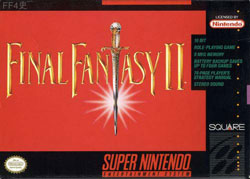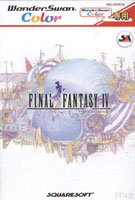| Product History of Final Fantasy IV |
| A Look at the Confusing History of the Video Game |
--Some box covers on this page may be clicked for larger images--
The story of Final Fantasy in North America is a rather confusing tale. As any fan of the games in the series can tell you, especially fans initiated with the first installment of the game. However the subject of this article focuses mainly on Final Fantasy IV's product history, which is probably one of the most confusing of all the games. This often makes it tough for fans to know exactly what the real story is. Therefore, to "blow back the mist" let us start at the beginning, the very beginning of Final Fantasy...
In 1985 The World Was Not So Square...More Like Totally Gnarly
Do you remember the 80's? Perhaps... In America 1985 was the middle of the decade of decadence, of Regan, He-Man and the Thunder Cats, high-tops, big-hair metal rock and electronic pop, florescent colors, and all kinds of other things... However anyone at all interested in video games that was old enough remembers 1985. It was the year of Nintendo. In Japan it was called the "Famicom" (NFC), a typically Japanese foreign word combination that means "Family Computer", and in America it was called the "Nintendo Entertainment System" (NES), or in general referred to as "The Nintendo".

The Nintendo NES® and Famicom® Systems
Whatever the name some say the world changed forever, though I'm not sure it's that important. However, what was important was the way the Nintendo revolutionized console computer games like no other home video game device had since the original Atari. The word Nintendo began to synonymize "video games" the way "Coke" does soda pop. After the the implosion of the console gaming industry in the early 80's, Nintendo had successfully brought it back with a vengeance, ushering in the great "third generation" of console gaming. Soon households all over the world had the little gray boxes on top of their TV sets. With Nintendo's huge success came huge profits, and with huge profits came everyone else looking for some action. Soon independent video game developers were looking to do exactly that, and garner themselves a slice of the pie. New software companies came into existence, armed with licenses from Nintendo to develop for the console. One of these companies formed in September of 1986, it was called Square (Square Co. LTD).
Initially Square created traditional games for the system, but began to champion the "Famicom Disk System" (FDS), which was an external disk drive for the Famicom. It looked like a 3.5" floppy disk drive, with similar looking media (in case you ever wondered, that's what the large port on the bottom on an NES was supposed to be for). In fact Square Co. was a partner in a Japanese game software union called DOG "Disk Original Group" to develop games for the Famicom FDS. Unfortunately DOG and indeed the FDS was a financial failure bringing Square Co. to the brink of Bankruptcy.
A Final Financial Fantasy
Around the time of the failure of the FDS there was a Square game developer named Hironobu Sakaguchi. Mr. Sakaguchi had designed a role playing video game similar to the very popular Enix Co. "Dragon Quest" RPG. This game was intended to be the last game Mr. Sakaguchi would develop therefore he named it "Final Fantasy". As well Square hedged it's bets on the game and believed that if it failed it would be the final game they would produce.

The Original Japanese Box Art for Final Fantasy NFC, Features Artwork by Yoshitaka Amano
What followed was a windfall for Square, Final Fantasy became a huge success in Japan, and indeed saved the company. Like any successful media creation it was followed by sequels; Final Fantasy II in 1988 and Final Fantasy III in 1990. This brings us to our subject Final Fantasy IV...or does it...
The Fourth Final Fantasy...Or The Fifth?
By the time of Final Fantasy III's release, the video game industry had already begun to transition from the "Third Generation" of 8-Bit systems to the "Fourth Generation" of 16-Bit systems, as was initiated largely by the popular acceptance of Sega's "Mega Drive" system in Japan in 1988 and the identical North American "Genesis" system in 1989. Not to be outdone, Nintendo's new console, the Super Famicom was brought to market 1990. Thus most developers set their sites on the new powerful 16-Bit systems.
It is important to note that although Final Fantasy was very successful for Square, they were still a rather small company. To maintain or to enlarge their stature they needed to continue releasing innovative new games. This is probably why in early 1990 they announced the next two upcoming games in the series, one for the Famicom to naturally be called "Final Fantasy IV", and yet another game "Final Fantasy V" for the Super Famicom.
Wait a minute, Final Fantasy IV is a Super Famicom game right? Well not originally. Apparently Square had developed a fourth installment of the series for the Famicom, though never fully completed or to what extent it ever was is known, details about it were released and an article published in a Japanese video game magazine. This article included the basic premise of the game which would have apparently included various job classes and had an interesting twist on the airship technology. The article even included an in-game screenshot of what appeared to be a demo, but was probably simply a mock up to show what the game would probably have looked like to executives and the press.
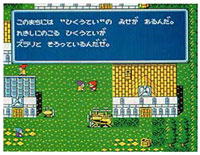
The infamous Final Fantasy IV NFC "Demo Screenshot"
Since the new 16-Bit Super Famicom and the established Mega Drive were already becoming the preeminent consoles of their day, continuing to develop for the quickly depreciating Famicom must have seemed like a waste of resources. Thus Final Fantasy IV Famicom became the Final Fantasy that never was. Square then focused on the SFC project under development which was working as Final Fantasy V but, would become what we know as Final Fantasy IV. By July of 1991 Final Fantasy IV for the Super Famicom was completed, and released in Japan, to high acclaim.
The Original Japanese Final Fantasy IV SFC Box
The Localization Obfuscation
While Final Fantasy had enjoyed success in Japan in 1987, it was not localized and released in North America until much later in 1990. Very late in the game for the Nintendo's commercial lifespan. Dispite this, Final Fantasy II was initially planned for a North American localization and a prototype was even produced with a partial English script. However it was later canceled.
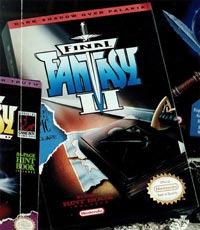
A conceptual image of box art for the canceled Final Fantasy II NES port.
A working subtitle for the game was "Dark Shadow Over Palakia".
Looking at this time frame, one recognizes that to localize and export both of the original Famicom Final Fantasy sequels would have made for a poor business decision. Not only would localizing both Final Fantasy II & III be costly and time consuming, but the cut-throat, quickly changing video game industry and its corresponding consumer base demanded the newest, cutting edge technology with every new release. While both of the Famicom sequels were improvements on the original Final Fantasy mould, they would not stand up against 16-Bit competition. Therefore Square decided to focus on localizing the new SFC Final Fantasy IV in North America on the Super Nintendo. The Super Nintendo had only just hit the North American market early in 1991. This meant the localization of Final Fantasy IV on the SNES would be the first major RPG title in North America for that console.
While this is all well and good, the problem was the name. And this is probably the biggest confusion of all in Final Fantasy IV's history, especially in North America. Presumably to keep consumers from questioning missing games, or just to be logical since it would be the second "Final Fantasy" to get localized, Square's North American subsidiary "Squaresoft" chose to release Final Fantasy IV for the Super NES as "Final Fantasy II" in November of 1991. However I would also conjecture that since the Final Fantasy series is non-linear (each game contains vastly different story lines and characters) that making it obvious that here were two missing games might cause consumers to wonder "what they had missed" in terms of a story line, when in fact they had missed nothing of that sort, only missing out on new adventures. Whatever the case was for the name change, it happened. Thus consumer ignorance is bliss at the checkout counter.
Final Fantasy II SNES Box, However on Close Inspection the product number on the box is
"SNS-F4-USA" for "Super Nintendo System Final Fantasy 4 USA"
Final Fantasy IV was followed in Japan by Final Fantasy V in 1992 and Final Fantasy VI in 1994. Final Fantasy V was skipped for North American release, however Final Fantasy VI wasn't. Again the numbering ploy was used later in 1994 when Final Fantasy VI was released in North America as "Final Fantasy III". As if this weren't confusing enough, things were further obfuscated when SquareSoft used the Final Fantasy name to brand two new game lines on the GameBoy in North America. One was the "SaGa" series which was released as "Final Fantasy Legend" and the other was the original "Seiken Densetsu" (Mana) series game called "Final Fantasy Adventure".
It wasn't until Square released Final Fantasy VII to both Japan and North America as Final Fantasy VII that the fact of the obfuscation was revealed, well at least it made it obvious that there were three missing numerated Final Fantasy games.
A Big Fat Dummy
While it was good that Final Fantasy IV was released in North America, and while that version "Final Fantasy II" was a great game, much to the chagrin of many gamers it was a rather sad port overall. The translation of the script was rather rough and much was lost in translation. Most likely due to the difficult nature of translating Japanese to English (which isn't as straightforward as say, Spanish to English), as well as the software and hardware limitations imposed on the translators.
Perhaps the biggest problem was the process of cramming the English script into the space formerly occupied by Japanese text, which was a tricky process. It required that a type of compression be employed (for you nerds the hacking community calls it "Dual Tile Encoding" or "DTE") just to fit it all. In addition you can say more in Japanese with fewer of their Kana and Kanji than Latin languages can in Roman, Greek, and Cyrillic alphabets. Therefore much of the spacing was too small for proper length English words, names, and terms. Complicating things even further was that at the time game developers were hamstringed by Nintendo of America's strict content guidelines for localization. All religious type references were replaced by laconic terms like "Elder" instead of "Priest", "White" instead of "Holy", and "Wishes" instead of "Prayers". As well any "adult" alcoholic or sexual allusions or references were expunged no matter how innocuous. In terms of Final Fantasy IV this included the entire legendary Programmers Room, and of course the Baron Dancer who throws off her gown (only to show that she's wearing a dancer's leotard).
Furthermore, SquareSoft then softened the game in an attempt to make it easier. Character battle commands, magics, and many of the game's items were removed or "dummied" out; a term used because the word "Dummy" was inserted by the localization programmers in the code to overwrite the names and titles in the game. Among these modifications was that game's vaunted Active Time Battle system is fixed in "Wait" mode, where the ATB counter waits for the player to make selections from the in-battle menus, which makes the game much easier.
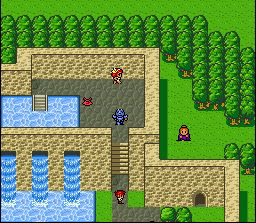

The Infamous Baron Dancer Cecil's Dummied Dark Wave Command
All this censorship, awkward reading (RPGs of this era are all about reading), and softening once discovered was extremely irksome. It thus caused some Final Fantasy fans to be thirsting to play the unadulterated game as it was originally intended to be played. Even if it meant bending the law...just a little.
I'll Take Mine The Hard Way
Final Fantasy IV has the distinction of being the "First" of many things:
- The first Final Fantasy on a 16bit console.
- The first Square RPG for both the Japanese SFC and the North American Super NES.
- The first Final Fantasy to employ the "Active Time Battle" (ATB) System.
- The first Final Fantasy to create a sense of depth and "realisim" for flight and other effects using the quasi-three-dimensional MODE7 graphics engine on the SFC/SNES.
- The first Final Fantasy originally offered in two levels of difficulty (in Japan).
- The first major RPG on the North American Super NES.
- The first classic "Nintendo Era" Final Fantasy to be ported to the PlayStation
The Japanese Final Fantasy IV SFC EasyType Box
Though many believe Final Fantasy II was a localization of Final Fantasy IV EasyType there is no proof that was the case. In fact based on the differences between the normal and EasyType Japanese versions including, slight modifications to items, monsters (most notably the final form of Zeromus) and other things present only in EasyType, it's far more likely that Final Fantasy II was a normal type localization. Both games, Final Fantasy II US and Final Fantasy IV EasyType, released very nearly back to back late in 1991 (late October for ET and Early November IIus), thus they were at least both in development at the same time. Perhaps the most factual thing to say is both EasyType and IIus were redeveloped versions of the normal game, and both followed similar plans for reducing the difficulty level.
In any case, many of the more "hard core" Final Fantasy gamers wanted to play the "Hard Type" of the game. This was especially prevalent during the late 1990's when ROM hacking of un-exported games became a fad on the internet. Sort of akin to "Scanlations" or "Fansubs" in Anime circles, video game ROM Hackers would take the raw Japanese games and attempt to translate them so they could be played, via console emulation software, on a typical desktop computer. Though this usually focused on games which were never localized, and probably the most famous Final Fantasy ROM hack was for Final Fantasy V, hacks for Final Fantasy IV "HardType" were also popular.
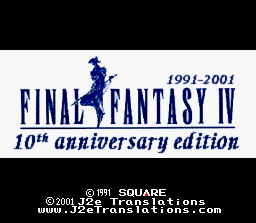
A graphics hack in the Final Fantasy IV ROM done by J2e adding a new title banner.
Perhaps the most famous (or infamous depending on your point of view) Final Fantasy IV "Hard Type" ROM hack was done by a group of hackers, translators, assembly programmers, and fans known as "J2e Translations". The final version of their efforts was an IPS Patch for the SFC ROM known as "Final Fantasy IV - 10th Anniversary Edition" as it was released in 2001.
A Fistful of Fantasy
2001 would be a good year for Final Fantasy IV, not only was there a high-quality patch for playing the game via emulation, but also because that was the year Square did a completely new localization of the original game and released it in North America as a PlayStation port. However it almost didn't happen. For the reason why, we need to rewind to 1997.
In 1997 two things happened, Square released probably their most profitable property to date; Final Fantasy VII and they ported Final Fantasy IV to the PlayStation, including all new CGI opening and closing movies, to the Japanese market. For better or worse Final Fantasy VII catapulted the Final Fantasy franchise to star status among nearly all gamers. Though, as mentioned earlier, it revealed the numeration cover up, fortunately Square was going to remedy the situation.
It began with every new Final Fantasy after VII enjoying a North American and word localization, as well Square dug the "original six" out and began to port them to various consoles in Japan. As mentioned Final Fantasy IV was first ported in '97 and then later V, and VI were ported to the PlayStation. These were initially sold separately, then later bundled together as a game pack called "Final Fantasy Collection". It was intended that this bundle would be exported to North America, which would repair part of the numeration inconsistencies. However there was a snag; Final Fantasy V had never been translated and Square apparently realized that Final Fantasy IV needed a fresh translation. This was made evident in 1999 when the North American version of "Collection" called the "Final Fantasy Anthology" game pack was released it only included V and VI. At the time it was cited that the cost and time involved in translating Final Fantasy V had left no time for a rework of Final Fantasy IV to be included for the release of Anthology. Though having V for the first time and having VI again was rather nice, for some of us not having IV wasn't.

The Final Fantasy Chronicles Game Pack Featuring Final Fantasy IV.
Whether Square originally intended it or not, there was something of an outcry for Final Fantasy IV when it wasn't included in Anthology. As well some gamers were clamoring for ports of other vintage Square games, notably the immensely popular SNES RPG "Chrono Trigger". Regardless of whatever it was that made the the case to Square they eventually gave in, and in 2001 another game pack, unique to North America, called "Final Fantasy Chronicles" was released. This pack contained two game ports. The first was an unadulterated version Final Fantasy IV (the "Hard Type") with the CGI movies of the 1997 PSx port and a fresh new English script. The other game was a special edition of Chrono Trigger with animated in-game cut scenes done by Akira Toriyama, famous for the anime series "DragonBall", and who had originally designed the Chrono Trigger characters. Finally, after 10 years, Final Fantasy IV had been released, in its original difficulty level and with its original content to North American and English-speaking audiences. And the masses rejoiced in all that was Final Fantasy IV. While the story might have ended here, Final Fantasy IV would continue to live on.
The Wonder Years
Have you ever heard of a WonderSwan? Chances are if you live outside Japan, probably not. WonderSwan is a hand-held game system from the Fifth Generation of console gaming. It was designed by Gunpei Yoko, who had originally designed Nintendo's GameBoy. Yoko had also developed Nintendo's VirtualBoy system, however its commercial failure led to his ostracization from within Nintendo and ultimately his resignation. After he left Yoko began an independant company called Koto and began development on what would become the WonderSwan hand-held console in a partnership with Bandai. The WonderSwan's purpose was to compete directly against the GameBoy system.

The WonderSwan, SwanCrystal Version.
Unfortunately Gunpei Yoko was killed in an auto accident in 1997, though the WonderSwan system survived. Indeed, though originally black and white, it was a for the most part a 16-bit console and the next generations, WonderSwan Color and the WonderSwan SwanCrystal had color screens.
While the ability to compete with Nintendo was rather slight, a huge opportunity lent itself when Square made the decision to partner with Bandai to release exclusive versions of it's older Famicom and Super Famicom games for the WonderSwan. Now, you might ask why would RPG giant Square port a game to a relatively unknown hand-held console system and not one of the extremely popular Nintendo GameBoy systems? A large part of the reason for this was the breakdown in relations between Nintendo and Square.
Round about 1995-96 the console gaming industry was again in transition, and this time to the "32/64 Bit" systems of the Fifth Generation were beginning to take hold. Square was developing it's next generation console games, as many have seen with the screen shots of the SGI demo Square produced using Final Fantasy VI characters in a fully 3D environment. However what Square was really cooking up, Final Fantasy VII, was rather ambitious. A game like Final Fantasy VII would likely need a large deal of memory, a constraint that hindered development on cartridge based systems. Indeed it did as is evidenced by the three CD-ROMs the game required. Here was the rub. The Super Nintendo's successor, the "Ultra 64" which simply became the "N64", was going to be a cartridge based system. And for Square this simply wouldn't do. They ultimately left developing for Nintendo. That and perhaps there was no love lost because of residual bad feelings left over from the failure of the original FDS system that almost bankrupted Square in the first place.
Where the FDS had sunk into obscurity, something else like it didn't. Sony had designed a little known prototype CD Drive system for the Nintendo Super Famicom which was similar to the Sega-CD system. When it was rejected by Nintendo for both the SFC and for use in the new N64, Sony independently developed it into the PlayStation.
In essence Nintendo ultimately lost console market share to Sony, who captured the Fifth Generation of consoles. As well, when Square left Nintendo, they began developing for Sony's new console. Thus Nintendo also lost a flagship software developer, which cost them system sales as well, as it could be argued that among other things, Final Fantasy VII and the whole franchise was one of the things that made the PlayStation, almost like Halo has for X-Box. For Nintendo this was adding an insult to injury, and for Square Nintendo's reluctance to use the newer CD technology was frustrating. With this animus between the two companies, Square porting games to Nintendo's popular GameBoy systems was not an option for Square, so the WonderSwan it was.
Now it's not completely obvious why Square was interested in porting old games to a handheld like the WonderSwan anyway. Most likely, one might conjecture, that porting old 8 and 16 bit games made sense. Especially since they were more than 10 years old, young gamers could play old games as new ones they'd never played before and older gamers could play a cherished classic again. That and the games were already conceptualized and built thus reducing lead time on development. Square indeed released Final Fantasies I and II for the console, and then in 2002 they ported Final Fantasy IV for the WonderSwan Color. Final Fantasy IV WonderSwan Color Box, Featuring Amano's "Lunar Whale" Artwork.
Rather than doing straight ports of these old games though, Square did them one up and improved their graphics to levels meeting the graphics quality of late 16bit powerhouse games like "Chrono Trigger", "Seiken Densetsu 3" and, "Final Fantasy VI". The upgrade to Final Fantasy IV can be witnessed below.
IN THE TOWN OF BARON NEAR THE AQUADUCT

WonderSwan Color Original Super Famicom*
*The Super Famicom screenshot has been cropped to the same size as the WSC one.
This was a really great improvement for Japanese gamers, but sort of left export audiences out, as the WonderSwan was not commercially available outside Japan except through indirect or online sources. The nail in the coffin was when Nintendo finally struck back with the GameBoy Advance, and virtually killed any chance the WonderSwan and any other hand-held console had. Soon thereafter it fell into the gloom of obscurity shared by the likes of the Atari Lynx and Sega GameGear. This left many Final Fantasy fans wondering if these graphically improved versions of the classic games would ever be ported to more traditional console formats in the future.
For Final Fantasy I & II, this became a reality in 2003 with the release of the "Final Fantasy Origins" game pack for the PlayStation, which included both the WonderSwan versions of Final Fantasy I & II, marking the first release of Final Fantasy II in North America. Both games got the royal treatment of lots of bonus features, CGI movie openers, and a CD-quality sound score. As well both had completely fresh English translations. However since Final Fantasy Chronicles had really only just come out, the outlook on a port of Final Fantasy IV - WS to the PlayStation was dubious. For most Final Fantasy IV fans, importing the WonderSwan console and that version of the game was the only way to play it. Fortunately this problem wouldn't last for long.
Making Advances

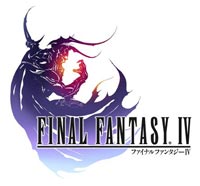
© 2007 The Light Crystal Network.
In 2003 the gaming community was stunned by the announcement that Square would be merged with RPG giant and long-time rival Enix. The newly created "Square-Enix" would be headed up by Square executives and instantly became the RPG video game company worldwide wielding both the "Dragon Quest" and "Final Fantasy" properties. Perhaps as part of this merger the first Square game for a Nintendo console in years, "Final Fantasy Crystal Chronicles", was announced for the GameCube. Not long after in 2004, under the new Square-Enix banner Final Fantasy I & II was ported onto the GameBoy Advance as "Final Fantasy I & II Advance" in Japan, and later "Final Fantasy: Dawn of Souls" in North America. It was then learned the Square-Enix was planning to release not only an "Advance" version of Final Fantasy IV but V and VI as well, as a part of their "Finest Fantasy for Advance" series of games.

Final Fantasy IV Advance Box, Features All New Artwork by Yoshitaka Amano
In 2005 perhaps the definitive 16-Bit version of Final Fantasy IV was released for the GameBoy Advance. While it was for the most part a port of the original SFC version of the game (with some mild tweaking to the difficulty level) it did sport the new graphics used for the WonderSwan port. Other new features included in-game-style event sequences at the beginning, including a new Mode7-style intro movie, and some Mode-7 style graphics on the world map were added, for example the Tower of Bab-il and Castles appear somewhat three dimensional. Further "bonus features" included a bestiary unlocked by playing the game and defeating monsters, two new bonus dungeons, much more powerful "ultimate" weapons and equipments, and the ability to swap party members among all the playable characters (except Tellah and FuSoYa) towards the end of the game. Even the character's menu portraits were redone and added to the text boxes like so many other 16-Bit RPG's. Incredibly this version also included yet another English translation which, except for a few oddities, exceeded the 2001 Final Fantasy Chronicles English script. There were also other special bonuses which came with the new release. Yoshitaka Amano, the famous artist involved in the artistic look of almost every Final Fantasy, did new artwork for the game including a beautiful new poster used as the box cover art. Another really cool bit of merchandise was that the Japanese version of the game could be purchased as a special deluxe box set. This set included an exclusive blue and white GameBoy Advance Micro console sporting artwork by Amano on the front case. With all the improvements and bonuses, for the most part this was an exciting port and well recieved by fans of the game and the Final Fantasy series. Most felt this would be "it" for Final Fantasy IV for some time to come, however again the story doesn't end here.
Not Your Father's Final Fantasy IV
Around about 2006 details began to leak out about Square-Enix's plans for the 20th anniversary of the Final Fantasy franchise (1987-2007). Now earlier in 2006 Final Fantasy III, the lone Final Fantasy never ported out of Japan, had been redeveloped as a 3D game and ported to the Nintendo DS handheld platform to high acclaim. As incredible as a full 3D port and redevelopment of an old 8-bit game is, and this marked the first time every Final Fantasy game was available to the North American market, nobody expected what would be ported next; Final Fantasy IV.

The Newly Released Final Fantasy IV DS Title Logo.
While originally Final Fantasy IV was the first Final Fantasy to use the now typical typeset for its title,
an image of the Character Cain Highwind was used as the Avatar.
It Now Features a new Amano-Designed Avatar of Golbez.
As part of the 20th anniversary celebration Final Fantasy IV is, at the time of this writing, under development for the Nintendo DS. For the Final Fantasy IV fan this is immense news. A port of this type is the ultimate fan's dream. Many of us had dared wonder if older console games, like Final Fantasy IV would ever be redone as 3D games. With the precedent now set with Final Fantasy III, it really is happening!
Among the obvious changes that will come with a 3D version of a 16-Bit game, it is believed that there will be CGI movies, and at least one piece of music will be arranged with vocals. Nobuo Uematsu, the esteemed composer of most of the music in the Final Fantasy world, has on his website an open call for vocalists for the "Theme of Love" (also known as "Rosa's Theme"). As well the characters in the game will be vocalized in some parts meaning that the characters will all be speaking for the first time. Furthermore, interviews with Square-Enix staff working on the project hint at the fact that the game will not only include the original material developed for the game but also more details and possible story elements that had to be "cut" from the original due to time and design limitations.
Overall the signs look extremely exciting that this will be the best port of Final Fantasy IV yet. Currently Square-Enix is pointing to a 4th Quarter 2007 release of the game in Japan. Details of a North American release are yet unknown however it is highly likely to become a reality based on the success of Final Fantasy III DS.
The Way Of The Future...
Obviously, Final Fantasy IV's long and complex history is often confusing and dissapointing, but also exciting and incredible. Since IV's original release on the Nintendo Super Famicom in 1991, the game has been available for the PlayStation, WonderSwan, Gameboy Advance, and is currently under development for the NintendoDS. This gives Final Fantasy IV the dubious distinction of having more versions across multiple hardware platforms than nearly any other Final Fantasy game, other than the original "Final Fantasy".
Looking back over this time I marvel at the different forms, changes in story, characters, elements and game play that have been made to this game. How it has been changed, translated, up-ported, been dumbed-down and improved, and even completely redesigned...at how it has evolved I notice one thing that is consistent; its appeal. Final Fantasy IV has a cult following with in RPG gamer circles and Final Fantasy fans. The communities of fans that have emerged around this game from Japan, America, Australia, Europe and the world are a testament to that. Simply looking at the fan-based websites on the net such as Sygnus.org, NotSerious.info, or Dawezy.com and you can see the lasting popularity of the game. Indeed almost every time it has been released it seems to do well for Square(-Enix). And though Square-Enix may claim that they continue to release the game to make money, and certainly that's the point, the game wouldn't continue to sell if it weren't so well loved by long time players and new gamers alike. A large part is that the fans make the game what it is, whether Square-Enix would admit to that or not. Only truly successful companies create quality products that consumers want to buy, and the simple marketability of a 16+ year old video game is also a testament to its lasting appeal as well as a testament to its engaging story and characters and the talented people who developed the game those many years ago.
The past, present, and future of this game is really rather amazing. I choose to be optimistic that this humble video game and it's siblings will continue to entertain audiences for many years to come, indeed that there is nothing final about these fantasies.
Content researched on the internet and written by Paladin.
Some information is based on conjecture and deductive reasoning and may not describe actual events as they happened.
Sources:
Final Fantasy, Square-Enix, Nintendo, and Wonderswan historical information:
Final Fantasy II NES Prototype and Final Fanatasy IV NFC Mock Up Information:
© 2007 The Light Crystal Network.

